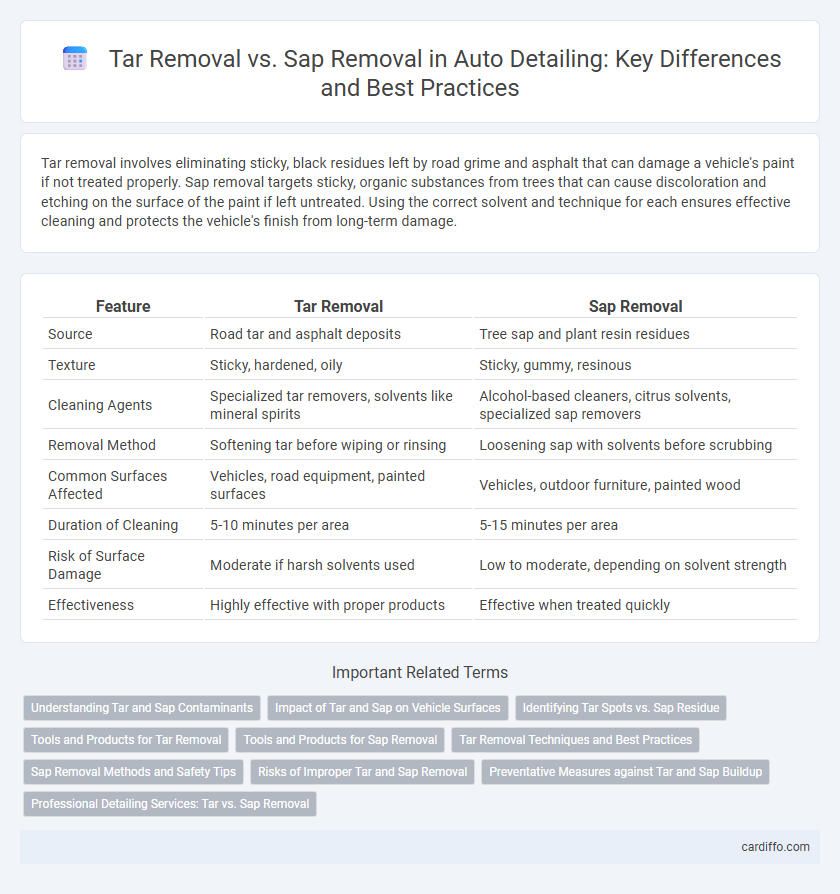Tar removal involves eliminating sticky, black residues left by road grime and asphalt that can damage a vehicle's paint if not treated properly. Sap removal targets sticky, organic substances from trees that can cause discoloration and etching on the surface of the paint if left untreated. Using the correct solvent and technique for each ensures effective cleaning and protects the vehicle's finish from long-term damage.
Table of Comparison
| Feature | Tar Removal | Sap Removal |
|---|---|---|
| Source | Road tar and asphalt deposits | Tree sap and plant resin residues |
| Texture | Sticky, hardened, oily | Sticky, gummy, resinous |
| Cleaning Agents | Specialized tar removers, solvents like mineral spirits | Alcohol-based cleaners, citrus solvents, specialized sap removers |
| Removal Method | Softening tar before wiping or rinsing | Loosening sap with solvents before scrubbing |
| Common Surfaces Affected | Vehicles, road equipment, painted surfaces | Vehicles, outdoor furniture, painted wood |
| Duration of Cleaning | 5-10 minutes per area | 5-15 minutes per area |
| Risk of Surface Damage | Moderate if harsh solvents used | Low to moderate, depending on solvent strength |
| Effectiveness | Highly effective with proper products | Effective when treated quickly |
Understanding Tar and Sap Contaminants
Tar and sap contaminants both adhere to vehicle surfaces but differ in composition and removal methods. Tar is a sticky residue from asphalt and road materials, requiring solvents or specialized tar removers for effective breakdown. Sap, a natural plant secretion, often requires gentle cleaners or citrus-based solutions to avoid damaging the paint while lifting the sticky residue.
Impact of Tar and Sap on Vehicle Surfaces
Tar and sap both create stubborn residues that can damage vehicle surfaces over time if not properly removed. Tar often hardens and adheres strongly to paint, leading to stains and potential clear coat degradation, while sap's acidic properties can cause discoloration and etching on the paintwork. Effective removal techniques are essential to preserve the vehicle's finish and prevent long-term surface deterioration.
Identifying Tar Spots vs. Sap Residue
Tar spots appear as hardened, glossy black patches that are sticky and difficult to remove, often bonded tightly to the surface of paint. Sap residue typically manifests as amber-colored, sticky droplets that can soften with heat or solvent application, making it easier to lift without damaging the finish. Identifying these differences is crucial for selecting the appropriate removal method, such as using specialized tar removers for tar spots and gentle sap-specific solutions for organic sap residue.
Tools and Products for Tar Removal
Effective tar removal requires specialized tools such as plastic scrapers, microfiber towels, and clay bars designed to safely lift tar without damaging paintwork. Chemical products like tar removers or adhesive removers contain solvents that dissolve sticky residues efficiently, ensuring thorough cleaning. Using a combination of these tools and products optimizes the removal process, preserving the vehicle's surface integrity and restoring smoothness.
Tools and Products for Sap Removal
Effective sap removal relies on specialized tools such as plastic scrapers and soft brushes to avoid damaging vehicle paint. Common products include commercial sap removers containing citrus-based solvents or isopropyl alcohol, which dissolve sticky residues without harsh chemicals. Using microfiber towels ensures gentle wiping and minimizes surface abrasion during sap extraction.
Tar Removal Techniques and Best Practices
Tar removal techniques involve using specialized solvents or commercial tar removers designed to dissolve sticky, oily residues without damaging vehicle paint. Best practices include applying the product to a microfiber cloth, gently rubbing affected areas, and rinsing thoroughly with water to avoid surface damage. Following up with a clay bar treatment can ensure complete removal of tar and improve the smoothness of the vehicle's finish.
Sap Removal Methods and Safety Tips
Sap removal requires specialized methods such as using rubbing alcohol, commercial sap removers, or gentle solvents to effectively dissolve sticky residues without damaging vehicle paint. Applying these products with a microfiber cloth and allowing them to sit briefly ensures thorough sap breakdown while minimizing surface abrasion. To ensure safety, always test the remover on a small area first, avoid harsh chemicals, and wash the treated area promptly to prevent any lingering residue or paint damage.
Risks of Improper Tar and Sap Removal
Improper tar and sap removal can damage automotive paint, causing discoloration, etching, or surface degradation due to harsh chemicals or abrasive techniques. Using incorrect solvents or scrubbing aggressively increases the risk of clear coat stripping and long-term finish deterioration. Professional-grade products and proper application methods are essential to avoid these risks and maintain the vehicle's exterior integrity.
Preventative Measures against Tar and Sap Buildup
Tar and sap buildup on vehicles can cause paint damage and corrosion if not addressed promptly, making preventative measures essential for maintaining a car's exterior. Regular washing with specialized automotive shampoos designed to break down tar and sap reduces adhesion and protects the clear coat. Applying paint sealants or ceramic coatings creates a protective barrier that minimizes the risk of tar and sap embedding into the paint surface, facilitating easier removal and long-term protection.
Professional Detailing Services: Tar vs. Sap Removal
Professional detailing services differentiate between tar removal and sap removal by using specialized products tailored to each substance's unique chemical composition. Tar removal often requires heavy-duty solvents that break down asphalt-based residues without damaging paint, while sap removal involves gentle, natural-based solvents to dissolve sticky, resinous plant excretions without harming the vehicle's finish. Expert detailers ensure effective removal by selecting appropriate techniques that preserve automotive surfaces and restore the vehicle's pristine appearance.
Tar Removal vs Sap Removal Infographic

 cardiffo.com
cardiffo.com